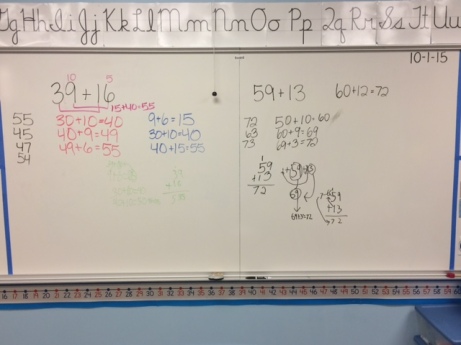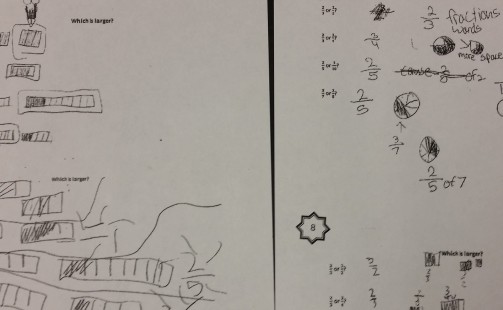

This post is a combination of Week 1 and Week 2 because it’s ‘One Good Thing’ about my job, and one of ‘My Favorite’ things, to be able to spend time with teachers and students and see amazing lessons happening!
As I was walking through the school hallway yesterday afternoon I was thinking through my day, preparing to write a post about A Day in the Life of me as an instructional coach. I had done a variety of things already that morning, and was excited to have a few minutes in my office to write it all down.
And then I walked my Mrs. Lane’s first grade classroom.
Let me tell you about Mrs. Lane. Her door is always open – literally and figuratively – and she has told me all year to come and join in whenever I want. I’ve taken her up on that many times, and I’ve seen cool social studies projects with Mind Missions, I’ve seen her students writing and conferring with each other, and I’ve seen Number Talks with thinking strategies that blow me away. Sometimes I stop in just to listen to her lesson for a few minutes, sometimes I confer with students about what they’re reading or writing or working on. Her students are amazing. They always know what they’re supposed to be doing and they are (almost) always doing it. They know how to have conversations with each other and can usually work well in partners and in groups. They also do well working independently. Mrs. Lane is able to have groups working with her often because the other students understand the clear expectations that she has set.
So yesterday as I was walking by her open door, I saw some students standing at the front of the classroom holding index cards, and the other students watching them. I had to check it out. Mrs. Lane was busy asking questions of the students and didn’t even notice me at first, and the students were so engaged in the conversation that they didn’t notice me either. The students at the front of the room had numbers on their index cards, 1, 2, 3, 4, and 5, and they were standing in order. Oh, ordering numbers! This should be good. Their conversation was just finishing, and Mrs. Lane had five new students come up. She handed each one an index card that they held up to show the rest of the class. The numbers were 11, 12, 13, 14, and 15, but they were not in order yet.
“As you look at these numbers, think about which one is the least, or smallest number.” She gave ample think time, and then asked the five students to put themselves in order. “Is this the number you thought would be first?” she asked, pointing at the 11. The students all agreed that it was. Then there was a group conversation about how they could tell if the numbers were in order or not. Amazing comments came from students, about counting and the order of numbers, and the number of tens being the same so they looked at the number of ones. Wow!
The whole process repeated with five more students, and this time there were ‘harder’ numbers. They weren’t in consecutive order this time; they were a variety of two digit numbers. I was anxious to see how the kids responded. Would this prove more difficult for them? Nope. The conversation was even more rich with math vocabulary, with think time, partner conversations, and whole group discussions, and the students were able to figure out the least and greatest numbers and the order of those in between.
Mrs. Lane moved on to giving each child a number card, and then splitting the class into 3 groups. Each group had to put themselves in order from least to greatest, and show their cards to the rest of the class.
Then for the finale – Mrs. Lane asked the students to find a partner, and each pair received a baggie of number cards. Their ‘game’ was to pull out 5 cards and put them in order, and then put them back and do it again. The first graders were overjoyed. Mrs. Lane was able to check in with groups, ask questions, redirect as needed, and clarify any misconceptions. After they were allowed some time to play, and when it was about time to go to lunch, Mrs. Lane asked each group to leave out their most recent 5 cards in order so she could check their work.
Thank you, Mrs. Lane, for allowing me into your classroom!!





































